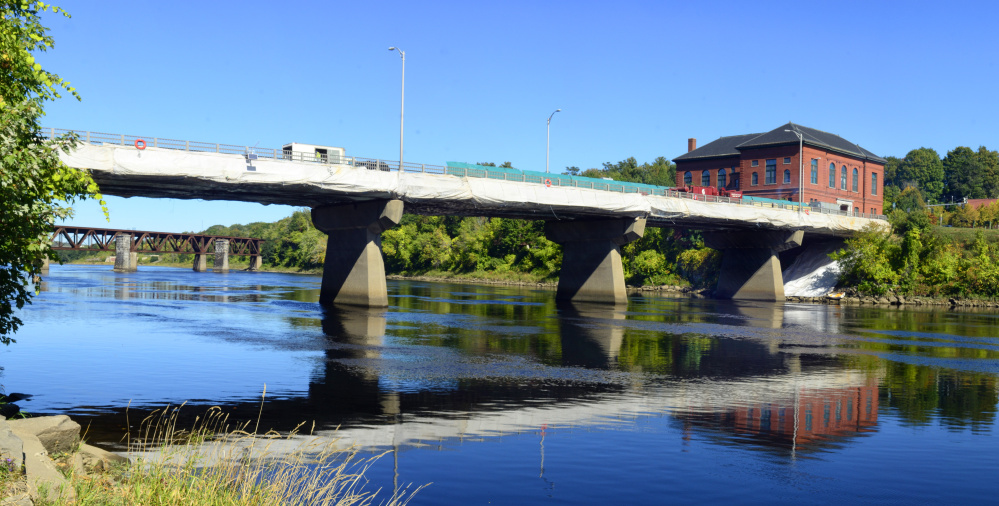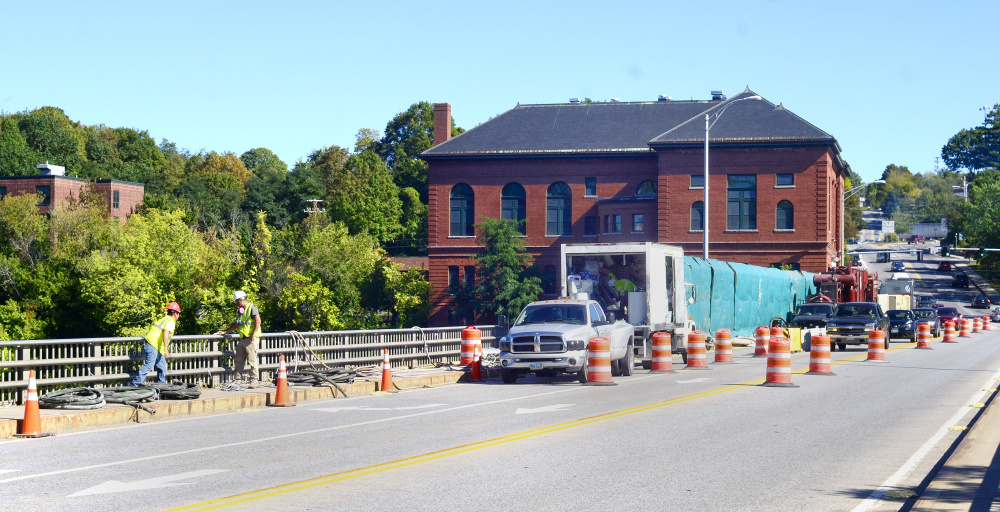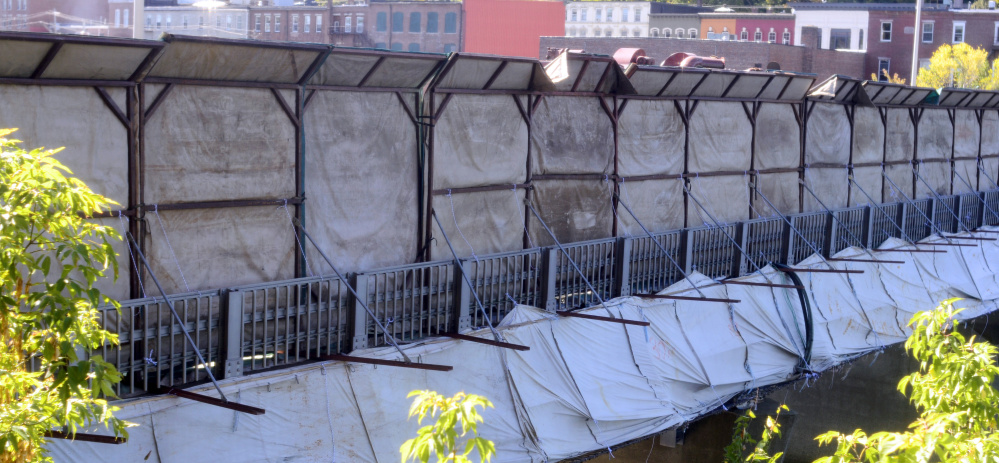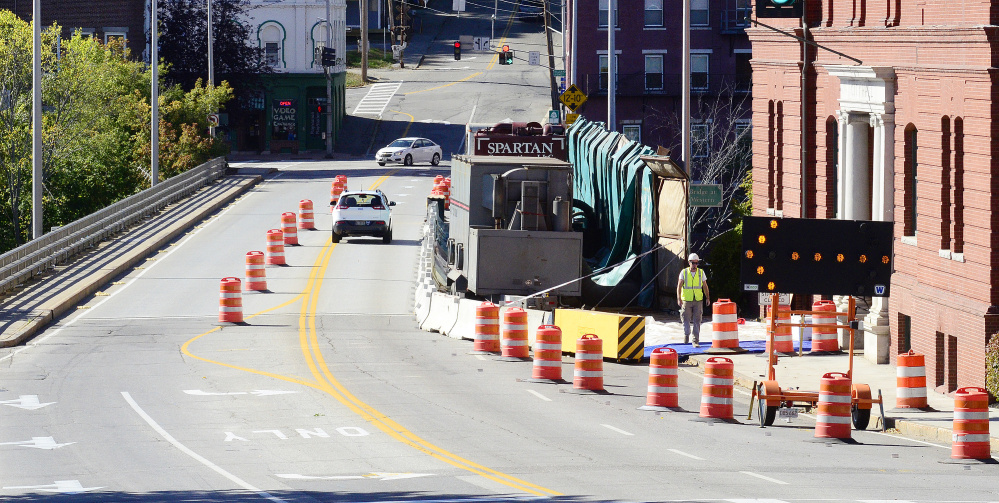AUGUSTA — The steady, pervasive humming noise of large pieces of equipment at work filled the air in all directions Friday around the Calumet Bridge at Old Fort Western.
Workers, out of sight inside a plastic-walled enclosure, blasted steel pellets at the underside of the bridge, removing old paint, probably lead-based.
The crew on the $750,000 project is blasting the worn paint off the 45-year-old bridge, the lowest of the three bridges that cross the Kennebec River in Maine’s capital city, so new “federal green” paint can take its place and help preserve the steel structure.
The paint job is meant to help preserve and protect the steel bridge from the elements and keep it from rusting and wearing our prematurely, according to Devin Anderson, senior project manager of the state Department of Transportation’s bridge program. He said the department anticipates it gets 25 to 30 additional years out of a bridge when it is painted.
The project is expected to be complete by mid-November, but the noisy part of it — taking place right now — is expected to wrap up by Wednesday, after which the work is expected to be less noisy.
That timing is fine for Linda Novak, director and curator of Old Fort Western. The historic fort property is just a few feet from the bridge and the work taking place above and below it.
However, Novak said the noise emanating from the nearby work site really hasn’t affected the fort, because this time of year is typically a slow period there. The summer tourist season has passed, and the fort is open only on Fridays, Saturdays, Sundays and Mondays in September. And it’s not yet time for the anticipated influx of leaf-peeping tourists into central Maine, some of whom boost the number of visitors who come to the fort for tours in the fall.
“If they’re getting done (with the noisy part of the project) next week, then it’s not going to impact us at all,” Novak said.
That doesn’t mean the noise can’t be heard at the fort — it can — but that hasn’t affected its operations.
“It sounds like an annoying lawn mower from here,” Novak said of the steady hum coming from the work on the bridge.
Anderson said the noise is significant and comes in low tones that tend to vibrate through structures, but the contractor is using roughly 15-foot-high sound wall barriers to help lessen the noise and prevent it from bothering residents of the Inn at City Hall, which sits only feet from the worksite.
“It’s a pretty significant noise, but not enough if you’re standing next to it with somebody, you can’t talk to each other,” Anderson said. “We haven’t heard any complaints about the noise, so that’s a good sign. I was down there the other day and I was happy with the noise. It sounded like the sound wall was pushing the noise away from the housing complex.”
The noise is from the combination of steel shot that is blasted against the underside of the bridge to remove the old paint, rust and anything else that shouldn’t remain there; and the large vacuum system and air-filtering equipment sitting atop the bridge deck that collects the debris that is blasted off the bridge.
Tarps are hung below the work area to catch any paint that falls off. Because it probably contains lead, an environmental hazard, the old paint and other debris is vacuumed into a recycling system and put into drums that, once filled, are taken to a site that takes hazardous waste for disposal.
Dust and fine particles from the work also is collected and filtered, with an air quality monitoring device on site to make sure the filtered air stays within allowable thresholds.
The new paint to be put on the bridge won’t be lead-based, which is no longer used. Instead the new paint will be zinc-based, according to Ted Talbot, spokesman for the state Department of Transportation.
Two-way traffic is expected to be maintained throughout the project. The Calumet Bridge has three lanes, and the equipment for the project is in the lane on the upstream side of the bridge, which is closed, as is the sidewalk on that side. That leaves the other two lanes, and the sidewalk on the downstream side, open to traffic and pedestrians crossing the bridge.
When department officials presented information on the project to the Augusta City Council in March, they said they expected the work to start in August.
However, the contractor of the job, Spartan Contracting LLC of Ohio, didn’t start until September.
Novak said that was fortunate timing for the fort, as well. If the work had started in August, it would have been ongoing during the fort’s peak summer season.
Anderson said the contractor could start the job anytime in August or later. The contract specifies the firm will be penalized financially if the work is not completed by Nov. 17.
He said this year the state had about $8 million worth of painting preservation projects done, on 17 bridges.
All but one of them, he said, were painted in the same “federal green” paint color prevalent on bridges. One bridge in Bath was painted more of a blue-gray color, at the request of local officials, Anderson said, so it would be less visible.
Anderson said he’s not sure why most bridges are painted that shade of green.
The contract for the job allows crews to work on the bridge between 6 a.m. and 9 p.m., Monday through Saturday, though Anderson said the company hasn’t been working that late at night.
The much larger Memorial Bridge, just downriver from the Calumet Bridge, was painted in 2012.
Keith Edwards — 621-5647
Send questions/comments to the editors.







Success. Please wait for the page to reload. If the page does not reload within 5 seconds, please refresh the page.
Enter your email and password to access comments.
Hi, to comment on stories you must . This profile is in addition to your subscription and website login.
Already have a commenting profile? .
Invalid username/password.
Please check your email to confirm and complete your registration.
Only subscribers are eligible to post comments. Please subscribe or login first for digital access. Here’s why.
Use the form below to reset your password. When you've submitted your account email, we will send an email with a reset code.